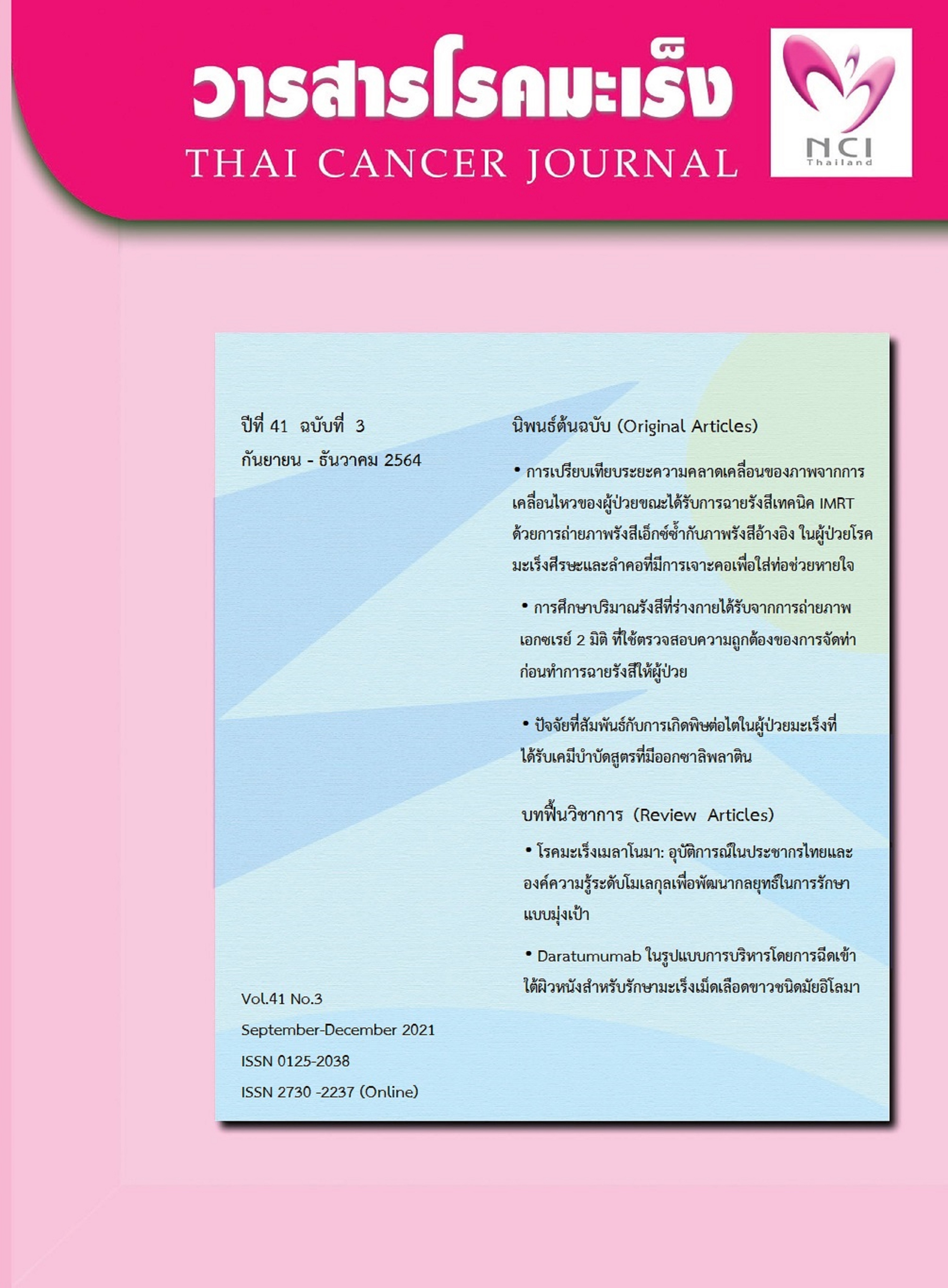The study of radiation adsorbed dose from the 2D KV image for set up verification to improve the precision and accuracy of treatment delivery
Keywords:
Chest cancer, Radiation absorbed dose, 2D kV image, Image-guided radiation therapy (IGRT), Volumetric modulated arc therapy (VMAT), OSL NanoDot dosimeterAbstract
This research aimed to study the radiation absorbed dose of the body from the Image-Guide radiation therapy (IGRT) process, which had to be x-ray for both sides (Anteroposterior: AP and Lateral: LAT). The study selected 30 volumetric modulated arc therapy (VMAT) technique plans from all patient treatment planning. The solid water phantom using the planning isocenter is set. Nanodot was placed on both sides of the phantom surfaces to put the optically stimulated luminescent dosimeters (OSL). Then, exposing x-ray on them for both sides by IGRT device from the Linac machine (Elekta InfinityTM) and recorded the value in a record form. Data were analyzed using Student t-test at a 95% confidence limit. The average absorbed dose from AP, LAT, and both sides were 0.498, 0.566, and 1.064 mGy by order. The data, which were compared with the reference dose limit from the American association of physicists in medicine task group 75 (AAPM-TG 75) protocol, must be less than 0.2 percent of the prescribed dose per fraction1, and it showed that there were not different (P=0.000). So, we can do IGRT before treatment in every fraction and do it more than once for each treatment. For a 50-60 Gy treatment delivered over 25-30 fractions, there will be less than 100 mGy of kilovoltage dose.
References
Murphy MJ, Balter J, Balter S, BenComo JA Jr, Das IJ, Jiang SB, et al. “The management of imaging dose during image-guided radiotherapy: Report of the AAPM Task Group 75”. Med Phys. 2007; 34: 4041-3.
Latty D, Stuart KE, Wang W, Ahern V. Review of deep inspiration breath-hold techniques for the treatment of breast cancer. J Med Radiat Sci. 2015; 62:74-81.
Broderick M, Menezes G, Leech M, Coffey M, Appleyard RM. “A comparison of kilovoltage and megavoltage cone beam CT in radiotherapy J of Radiother in pract. 2007; 6: 173-8.
ทวีป แสงแห่งธรรม. ระบบภาพในงานรังสีรักษา (Imaging in radiotherapy). มะเร็งวิวัฒน์ วารสารสมาคมรังสีรักษาและมะเร็งวิทยาแห่งประเทศไทย. 2559; 22: 16-23.
Foulkes KM, Ostwald PM, Kron T. A clinical comparison of different film systems for radiotherapy portal imaging. Med Dosim. 2001; 26: 281-4.
Herman MG, Kruse JJ, Hagness CR. Guide to clinical use of electronic portal imaging. J App Clin Med Phys. 2000; 1: 38-57.
Sorcini B, Tilikidis. A clinical application of image-guided radiotherapy, IGRT (on the Varian OBI platform). Cancer radiotherapy, 2006; 10: 252-7.
Yin FF, Wong J, Balter J, et al. The role of in-room kV X-ray imaging for patient setup and target localization. AAPM Report No. 104. Collage Park, ND: AAPM; 2009.
Ma CM, Paskalve K. In-room CT techniques for image-guide radiation therapy. Med Dosim. 2006; 30: 30-9.
Gurjar OP, Mishra SP, Bhandari V, Pathak P, Pant S, Patel P. A study on the necessity of kV-CBCT imaging compared to kV-orthogonal portal imaging based on set up errors: considering other socioeconomical factors. J Cancer Res Ther. 2014; 10: 583-6.
Dawson LA, Sharpe MB. “Image-guided radiotherapy: rational, benefit, and limitations”. Lancet Oncol. 2006; 7: 848-58.
ลัดดา เย็นศรี. การศึกษาเปรียบเทียบปริมาณรังสีที่ผู้ป่วยได้รับจากการถ่ายภาพรังสีทรวงอกด้วยระบบ CR และ DR. วารสารเครือข่ายวิทยาลัยพยาบาลและการสาธารณสุขภาคใต้. 2559; 3: 129-39.
เขมิกา เกื้อพิทักษ์, จุฑามาศ ทนานนท์, ปนัสดา อวิคุณประเสริฐ, สุนิสา แสงสว่าง, จิรภัทร เรืองศรีตระกูล, วิทิต ผึ่งกัน,และคณะ. การศึกษาปริมาณรังสีและปริมาณรังสีกระเจิงจากการตรวจด้วยเครื่องเอกซเรย์คอมพิวเตอร์ในหุ่นจำลอง.วารสารการแพทย์และวิทยาศาสตร์สุขภาพ. 2562; 26:19-28.
Downloads
Published
Issue
Section
License
บทความทีตีพิมพ์ในวารสารโรคมะเร็งนี้ถือว่าเป็นลิขสิทธิ์ของมูลนิธิสถาบันมะเร็งแห่งชาติ และผลงานวิชาการหรือวิจัยของคณะผู้เขียน ไม่ใช่ความคิดเห็นของบรรณาธิการหรือผู้จัดทํา







